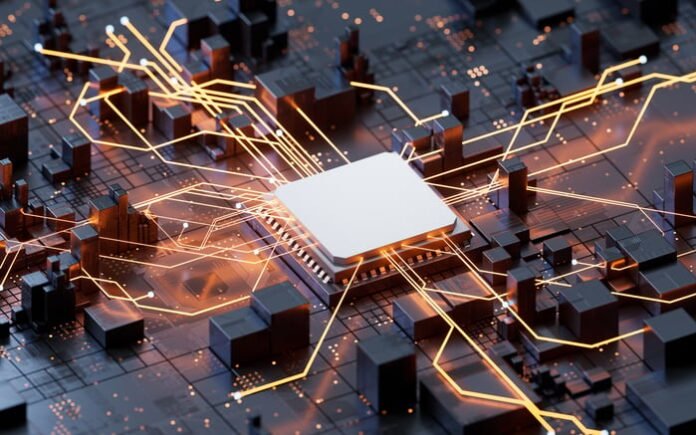The chipmaker must resort to drastic measures to stabilize its earnings progress.
Intel (INTC -2.63%), the world’s largest producer of x86 CPUs for PCs and servers, was as soon as a bellwether of the semiconductor sector. However over the previous 10 years, its inventory has dropped greater than 50% because it withered right into a much less priceless chipmaker than AMD, Nvidia, and Qualcomm.
Intel’s fall from grace was brought on by manufacturing issues, product delays, market share losses, and jarring strategic shifts beneath three CEOs. It missed the shift towards cell chips, centered an excessive amount of on slicing prices, and stored shopping for again its personal shares as an alternative of resolving its persistent manufacturing points or investing in new chips.
Picture supply: Getty Photographs.
From 2013 to 2023, Intel’s income had an anemic compound annual progress fee (CAGR) of 0.3%. AMD, which outsourced its manufacturing to Intel’s foundry rival Taiwan Semiconductor Manufacturing (or TSMC), had a CAGR of 15.6% throughout the identical interval.
That is why it wasn’t too stunning when a couple of latest reviews mentioned Intel was exploring some drastic choices to rightsize its struggling enterprise. Let’s examine if any of these rumored concepts will make its inventory price shopping for once more.
What are Intel’s primary issues?
Intel remains to be an built-in system producer, which means it designs, manufactures, and markets its personal chips. That units it other than fabless chipmakers like AMD and Nvidia, which outsource their manufacturing to third-party foundries.
Intel’s foundries as soon as produced the world’s most superior chips. However over the previous decade, it slipped behind its two Asian rivals, TSMC and Samsung, within the “course of race” to fabricate smaller, denser, and extra power-efficient chips.
Intel’s troubles began with a tough transition from 14 nanometer to 10nm chips (2018-2019) and worsened with much more delays in its subsequent transition to 7nm chips (2020-2023). These grueling delays drove many PC makers to switch Intel’s CPUs with AMD’s.
In keeping with PassMark Software program, which measures PC efficiency, Intel’s x86 CPU market share dropped from 82.5% to 61.8% between the third quarters of 2016 and 2024, as AMD’s share expanded from 17.5% to 35.4%.
In contrast to TSMC, which aggressively ramped up its analysis and improvement spending, Intel tightly managed its capital expenditures and put aside an excessive amount of money for share buybacks and dividends. Bob Swan, CEO from 2019 to 2021, even briefly thought of following AMD’s result in turn out to be a fabless chipmaker to completely resolve its manufacturing points.
Pat Gelsinger, who succeeded Swan, doubled down on increasing its first-party foundries to catch as much as TSMC and Samsung. That was a expensive technique: Gelsinger anticipated to offset these prices with authorities subsidies within the U.S. and Europe, however TSMC additionally secured a few of these authorities subsidies for its abroad crops.
Does Intel have to shrink to develop once more?
After Gelsinger took the helm, Intel offloaded quite a few companies, together with its Optane reminiscence chip, community swap chip, 4G/5G connectivity options, pre-built server, and cryptocurrency mining divisions. It additionally continued the multiphase sale of its NAND reminiscence chip division to SK Hynix, spun off its automotive chip division Mobileye, and liquidated its remaining shares of the cell chip designer Arm Holdings.
In early August, Intel suspended its dividend and mentioned it could lay off 15% of its workforce to save lots of as much as $10 billion by 2025. These stunning bulletins accompanied a dismal second-quarter earnings report that broadly missed analysts’ expectations as the corporate struggled to ramp up its manufacturing of its latest Meteor Lake chips.
The newest reviews counsel Intel would possibly spin off or promote its struggling foundry unit. That transfer would mirror AMD’s spinoff of GlobalFoundries in 2009, however it could additionally fully undo Gelsinger’s authentic plans.
If that occurs, Intel would possibly go fabless and considerably cut back its spending by outsourcing all of its manufacturing to the newly spun off unit or different foundries like TSMC. However taking that drastic step would merely make it much like AMD and subservient to TSMC.
Another rumors counsel Intel would possibly promote Altera, the programmable chipmaker it purchased in 2015. However that divestment would erode its defenses towards AMD, which acquired and built-in Altera’s prime competitor Xilinx in 2022.
Did Intel simply waste three years?
Intel hasn’t confirmed any of those rumors, however they suggest it is abandoning Gelsinger’s grand plans of reclaiming the method lead from TSMC by 2025. It additionally appears to be drifting again towards Swan’s concept of turning Intel right into a fabless chipmaker.
Doing so would possibly rightsize the enterprise and stabilize its earnings progress once more, however it additionally tells us the chipmaker wasted lots of priceless time and billions of {dollars} over the previous three years. That is why I imagine Intel’s concentrate on shrinking its enterprise is definitely a vibrant pink flag that would generate tailwinds for TSMC and AMD.
Leo Solar has no place in any of the shares talked about. The Motley Idiot has positions in and recommends Superior Micro Units, Nvidia, Qualcomm, and Taiwan Semiconductor Manufacturing. The Motley Idiot recommends Intel and Mobileye World and recommends the next choices: quick November 2024 $24 calls on Intel. The Motley Idiot has a disclosure coverage.

